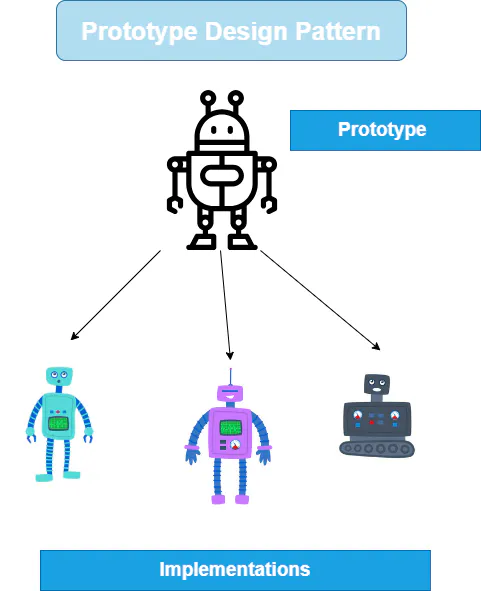Prototype Design Pattern
In this tutorial, we are going to discuss about the Prototype Design Pattern. Prototype Design Pattern is used when the Object creation is a costly affair and requires a lot of time and resources and you have a similar object already existing. This design pattern provides a mechanism to copy the original object to a new object and then modify it according to our needs. Prototype design pattern uses java cloning to copy the object.
The Prototype Design Pattern is a creational design pattern that involves creating objects based on a template of an existing object through cloning. This pattern is used when creating a new instance of a class is more expensive or complex than copying an existing instance. It’s particularly useful in scenarios where objects are dynamically created and the types of objects are not known until runtime.
Real-Life Example

The diagram illustrates the Prototype Design Pattern using the example of robots.
The idea here is that instead of building each of these three robots from scratch, which can be time-consuming and expensive, they are cloned from the prototype robot. This cloning process copies the features and characteristics of the prototype, and potentially, each clone can then be customized further if needed. For example, one might be programmed for talking, another for lifting, and the third for complex calculations.
This is the core concept of the Prototype Pattern: creating new objects by copying an existing object (the prototype) rather than creating new objects from scratch, which can be a more efficient way to produce objects that share similar characteristics or configurations.
Example
Suppose we have an Object that loads data from database. Now we need to modify this data in our program multiple times, so it’s not a good idea to create the Object using new keyword and load all the data again from database. The better approach would be to clone the existing object into a new object and then do the data manipulation.
package com.ashok.designpatterns.prototype;
import java.util.ArrayList;
import java.util.List;
/**
*
* @author ashok.mariyala
*
*/
public class Employees implements Cloneable {
private List<String> empList;
public Employees() {
empList = new ArrayList<String>();
}
public Employees(List<String> list) {
this.empList = list;
}
public void loadData() {
// read all employees from database and put into the list
empList.add("Ashok");
empList.add("Vinod");
empList.add("Dillesh");
empList.add("Latha");
}
public List<String> getEmpList() {
return empList;
}
@Override
public Object clone() throws CloneNotSupportedException {
List<String> temp = new ArrayList<String>();
for (String s : this.getEmpList()) {
temp.add(s);
}
return new Employees(temp);
}
}Now the prototype design pattern example test program that will show the benefit of prototype pattern.
package com.ashok.designpatterns.prototype;
import java.util.List;
import com.ashok.designpatterns.prototype.Employees;
/**
*
* @author ashok.mariyala
*
*/
public class MyPrototypePatternTest {
public static void main(String[] args) throws CloneNotSupportedException {
Employees emps = new Employees();
emps.loadData();
Employees emps1 = (Employees) emps.clone();
Employees emps2 = (Employees) emps.clone();
List<String> list = emps1.getEmpList();
list.add("Janaki");
List<String> list1 = emps2.getEmpList();
list1.remove("Dillesh");
System.out.println("emps List : " + emps.getEmpList());
System.out.println("emps1 List : " + list);
System.out.println("emps2 List : " + list1);
}
}Output
emps List : [Ashok, Vinod, Dillesh, Latha]
emps1 List : [Ashok, Vinod, Dillesh, Latha, Janaki]
emps2 List : [Ashok, Vinod, Latha]If the object cloning was not provided, we will have to make database call to fetch the employee list every time. Then do the manipulations that would have been resource and time consuming.
The Prototype Design Pattern is useful for scenarios where object creation is more expensive or complex than duplicating an existing object. It offers a flexible solution to dynamic object creation but requires careful implementation to handle complex cloning scenarios effectively.
That’s all about the Prototype Design Pattern. If you have any queries or feedback, please write us email at contact@waytoeasylearn.com. Enjoy learning, Enjoy Design patterns.!!